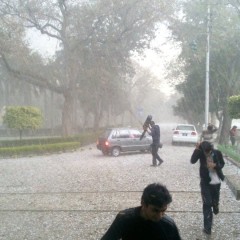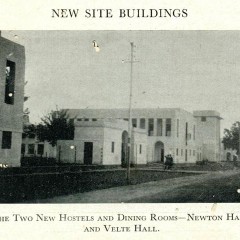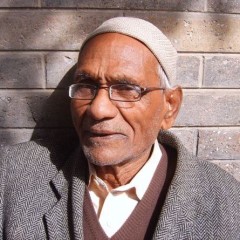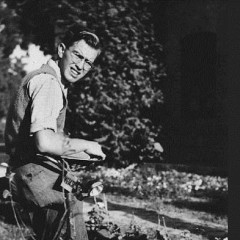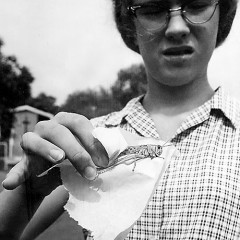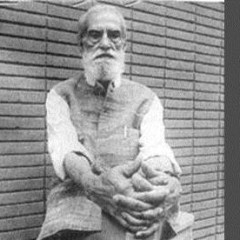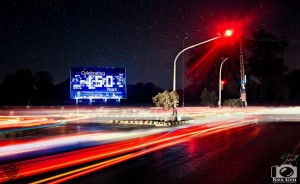Hailstorm at FCC
by Azka Ijaz It was a cold evening in February 2011, but still FCC was looking like the most crowded place ever at 5 o’clock. We were standing in the Ahmed Saeed Building and waiting for our token numbers for add/drop. Finally, after hours and hours, my token number was called. I came out of the building after adding a course and suddenly heavy rain started. But that was not all. With this heavy rain there was a hailstorm too. Everyone gathered at the entrance. Students were running towards the building. Ah! And after a few minutes a white layer of ice covered the whole of FCC. FCC was looking like a paradise on...
My Visit to the Camp
It was in the year 1937 that I came for my B.A. in the Forman Christian College. It was a remarkable change for I had shifted from a “pathshala” to a college, a college which is a college in every sense of the word. Since then I have been proud of it. But I have often felt inferior for I have a disqualification which I have always hesitated to disclose. All these years I have tried to hide the fact that I am not an “Old Camper.” I had never gone to the new site though I had read and heard much about it and knew everything about the new scheme of the authorities. Two camps had been held but I had yet to see what a camp was and what the new site looked like. It was one afternoon in the last week of March this year. I was sitting in a corner of the English seminar, turning the pages of The Cambridge History of English Literature, when suddenly a friend walked in with the news that Dr. Velte had been kind enough to postpone our examinations to the second fortnight of May. What a heartening news it was! It was a pleasant surprise. We all closed our books, and how to celebrate the good news became the topic of discussion. Some were in favour of going to see “Zindagi,” others were very emphatic in putting forward the claims of “Ninotchka.” I, being a non-camper, of course, was for paying a visit to the camp. My suggestion was not appreciated so I found myself among a microscopic minority. The musical sound of the library clock announced three and we were on our legs. I got only one companion and we both made our way to the camp. Cycling through Lawrence Gardens, in ten minutes we were on the Jail Road. A few minutes after we had taken the turn along the canal, I at once noticed the College flag flying high, a number of tents, some beautiful white buildings and bungalows and a small pillar enclosing a vast area of land. This sight revived in me the experiences of my childhood when in 1923 I had seen the beautiful city of New Delhi being erected in nearly similar conditions and surroundings. A crossing over the canal brought us to the “Forman Christian College Estate.” We did not know that Mr. Speers had succeeded by then in getting a fine pakka road leading direct to the main building of the College. As were going round the buildings, I saw a yellowish white car in the distance. I thought that...
Naseer Ahmed, the College Barber
Naseer Ahmed, the famous college barber, is part and parcel of FCC. He was a young man when he came from Dehra Dun (India) looking for a job and has spent most of his life here. He and his elder brother Shafiq started this barbershop in 1945. Now he is about 77 years old and runs the shop with his son Muhammad Idrees. He has a vivid and sharp memory of the past, which he calls a golden time. Lean and talkative, he speaks non-stop in a raspy voice about his past. You have to interrupt him to bring him to the present. He proudly announces that he has given a haircut to all the “Barey Sahibs” of this campus since 1945. All the teachers and students know him and he has been their hair stylist at some time or the other. Name any famous alumni of FCC, and he usually knows them and says “Those were great people – you can’t find such people nowadays.” He had the privilege of playing basketball with Dr S L Sheets in his younger days and played at the position of defender. He won matches and gained popularity with students and teachers. He remembers the treats given by Dr Sheets at the campus canteen after the matches. Past memories brings a spark into his old eyes. A loyal and devoted worker of FCC, he wants to continue working at the campus for the remaining part of his life. A brief interview was recorded with him. Naseer, how do you see the time now compared to the old days? The time has changed fast. Not that the people are not loving and caring, but now people don’t have the time to spare to sit together. They have isolated themselves and are completely absorbed in their own life. Can you give us some example? Yes. I used to go very regularly to the residence of Dr Sinclair for his haircut. We used to have discussions and he never let me return without a cup of tea. He was very particular about time. Once I was late by fifteen minutes and he asked me to go back and come the next day. That day I had borrowed a watch from someone, which gave the wrong time. Dr Sinclair was a man of principle. I remember that he turned out his son “Putty” from the college when he saw him smoking outside Velte Hall. Dr Sinclair was both the Principal of the college and warden of Velte Hall. His son went to England and joined the Royal Air Force. You were a good basketball player and...
An American in India
…Which brings me to the label of “American Indian”. Well, why not? My parents were American, but India was the land of my birth. I was conceived, born in 1925, and nurtured in the Bengal railway colony of Kharagpur, almost as a kind of affirmation by my parents that the family- which included my Pennsylvania-born older brother- was now Indian as well as American. My brother had arrived in Kharagpur with my parents in 1923, as a four-year old. My sister rounded out our family roster with her birth in Kharagpur three years after mine. It was Indian air that filled my lungs as I inhaled and bellowed for the first time, and it was produce of the Indian soil that nourished me through infancy and childhood. My Indian ayah watched, bathed, dressed, fed, and put me to sleep under mosquito net with Indian lullabies, and it was in her arms that I spoke my first word, chand, an Indian word, while pointing at the moon. The passport amendment bearing my name in my parents’ passport said “American,” but in so many other important respects, I was Indian. So what is my label? Probably not any one of these. It depends upon how one feels at any given time. But there was one revealing experience at the outset of my teaching career at Forman Christian College in Lahore, formerly in India, now in Pakistan. It was the first day of class at the opening of the fall term. I entered the room. The students, most of whom were wearing the dark-blue FCC blazer, all stood until I took my place at the front and gave them permission to sit. I called the roll without too much difficulty. The boys listened with what seemed to be a flattering degree of attention. All went well and the class ended. At that point I was surrounded by a circle of smiling young Punjabi and Anglo-Pakistani (formerly Anglo-Indian) men, one of whom said, “Sir, we are so happy. You are the only American we can understand!” What better endorsement of my identity could there ever have been than this?… Text source: American Indian in Kharagpur: Exploring a Personal Brand Name by Stanley E Brush, published in The Way We Were: Anglo-Indian Chronicles Images source: www.dadinani.com Note: According to http://www.dadinani.com/capture-memories/read-contributions/life-back-then/140-american-boyhood-british-india: After Stanley completed graduate work in sociology and religion, and Beverly [his wife] finished her nursing degree, they moved with their two young daughters, Cynthia and Victoria, to Lahore, Pakistan in 1952. Stan taught English and History at Forman Christian College and Punjab University. Beverly worked at United Christian Hospital. In 1963, Stan moved with his family to...
The Day of the Locusts
Locusts swarm over Forman Christian College campus hockey fields, Lahore Pakistan (1962) …I’d like to share an “outside-in” perspective on my childhood that was similar in many ways to the Anglo-Indian experience during the first half of the twentieth century. My parents moved to West Pakistan, the western portion of this new country, in 1952, a short five years after Partition. It was to be my childhood home for a decade. My sister hadn’t even reached her first birthday. I was an impressionable, curious, but less than cooperative two-year-old… …We lived in several places. Our first home was in the dusty rural village of Raiwand, connected to the rest of the world by the railroad, and to other villages by worn footpaths alongside the canal banks and rutted roads etched into the earth by heavily-laden bullock carts. Within a year’s time, we moved to Forman Christian College, a well regarded, men’s private educational institution, in the vibrant city of Lahore. My father taught English before finding his niche as a history professor. My mother employed her nursing skills by volunteering to keep United Christian Hospital patients’ charts and record up-to-date—each one written entirely by hand… …We experienced the locust swarms, spring of 1962. They descended over Lahore’s Forman Christian College campus like a swirling dust storm. My sister and I, my folks as well, dashed up to the second story verandah to have a locust’s eyeview of the green lawns, trees and hockey fields beyond the eucalyptus row and hedge. Mom recalls “bugs being everywhere.” Victoria remembers “going up on the roof…and banging pots with spoons,” which the wise adults informed us would deter the ravenous locusts – a type of huge grasshopper – from devouring the sports fields and denuding trees. (From my mature vantage point as an enthused gardener, the veracity of this practice seems dubious.) I do recall great excitement among the household adults, staff and my folks alike….a mix of anticipation and alarm….with little comprehension on my part for its basis. I also remember watching more experienced Pakistanis chasing them off the lawns and knocking quantities of locusts out of the sky and with big colorful cotton cloths. After 48 intervening years, none of us can recall if there was much damage done. Cynthe’s love of animals doesn’t extend to locusts (1962) Our family of four sat in designated places for dinner as usual. Sunlight slanting through the tall windows behind my back as we waited for the meal to be served. At some point, our cook and bearer from #15 (our house on the FCC campus) proudly brought us a heaping plateful of...
Birth of Lahore College of Art
…I also found the studio of art legend Bhabesh Chandra Sanyal, also known as B.C. Sanyal, who gave a new stroke to Indian art. Sanyal, born on 22nd April 1901, is the guru of the art of the undivided Indian sub-continent. In 1937, he set up a studio in the premises of the Forman Christian College, which later became an art school… (This school later came to be known as the Lahore College of Art) …A few years later, the Lahore College of Art was shifted to the Dayal Singh Mansions of the city, after Sanyal received a positive response and a huge turnout of the most popular artistes when he held an exhibition in the basement of the building. Sanyal remained as the teacher at the Lahore College of Art until India’s independence in 1947, after which he permanently migrated to Delhi… Text source 1: From Amrita Shergil to Lady Harrison: A Journey Through History, published in Dawn.com by Ali Zaef Text source 2: World Famous Great Painters by Vikas Khatri Image source: www.tribuneindia.com Note 1: Bhabesh Chandra Sanyal was an eminent painter more widely known as the Grand Old Man of Indian art. His preferred medium was watercolors through which he depicted rural life and the struggles of ordinary people among...



